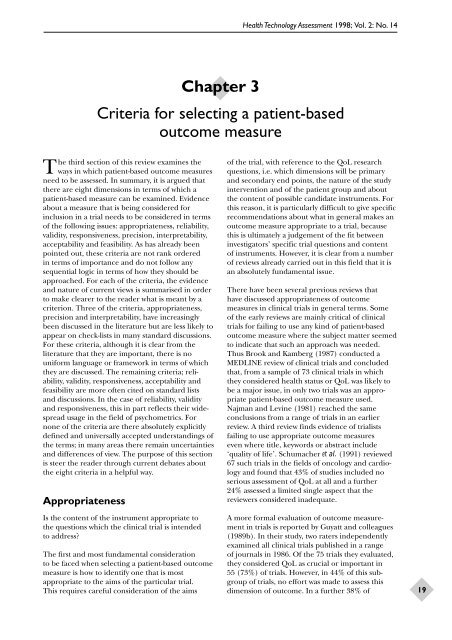Evaluating Patient-Based Outcome Measures - NIHR Health ...
Evaluating Patient-Based Outcome Measures - NIHR Health ...
Evaluating Patient-Based Outcome Measures - NIHR Health ...
Create successful ePaper yourself
Turn your PDF publications into a flip-book with our unique Google optimized e-Paper software.
The third section of this review examines the<br />
ways in which patient-based outcome measures<br />
need to be assessed. In summary, it is argued that<br />
there are eight dimensions in terms of which a<br />
patient-based measure can be examined. Evidence<br />
about a measure that is being considered for<br />
inclusion in a trial needs to be considered in terms<br />
of the following issues: appropriateness, reliability,<br />
validity, responsiveness, precision, interpretability,<br />
acceptability and feasibility. As has already been<br />
pointed out, these criteria are not rank ordered<br />
in terms of importance and do not follow any<br />
sequential logic in terms of how they should be<br />
approached. For each of the criteria, the evidence<br />
and nature of current views is summarised in order<br />
to make clearer to the reader what is meant by a<br />
criterion. Three of the criteria, appropriateness,<br />
precision and interpretability, have increasingly<br />
been discussed in the literature but are less likely to<br />
appear on check-lists in many standard discussions.<br />
For these criteria, although it is clear from the<br />
literature that they are important, there is no<br />
uniform language or framework in terms of which<br />
they are discussed. The remaining criteria; reliability,<br />
validity, responsiveness, acceptability and<br />
feasibility are more often cited on standard lists<br />
and discussions. In the case of reliability, validity<br />
and responsiveness, this in part reflects their widespread<br />
usage in the field of psychometrics. For<br />
none of the criteria are there absolutely explicitly<br />
defined and universally accepted understandings of<br />
the terms; in many areas there remain uncertainties<br />
and differences of view. The purpose of this section<br />
is steer the reader through current debates about<br />
the eight criteria in a helpful way.<br />
Appropriateness<br />
Is the content of the instrument appropriate to<br />
the questions which the clinical trial is intended<br />
to address?<br />
The first and most fundamental consideration<br />
to be faced when selecting a patient-based outcome<br />
measure is how to identify one that is most<br />
appropriate to the aims of the particular trial.<br />
This requires careful consideration of the aims<br />
Chapter 3<br />
<strong>Health</strong> Technology Assessment 1998; Vol. 2: No. 14<br />
Criteria for selecting a patient-based<br />
outcome measure<br />
of the trial, with reference to the QoL research<br />
questions, i.e. which dimensions will be primary<br />
and secondary end points, the nature of the study<br />
intervention and of the patient group and about<br />
the content of possible candidate instruments. For<br />
this reason, it is particularly difficult to give specific<br />
recommendations about what in general makes an<br />
outcome measure appropriate to a trial, because<br />
this is ultimately a judgement of the fit between<br />
investigators’ specific trial questions and content<br />
of instruments. However, it is clear from a number<br />
of reviews already carried out in this field that it is<br />
an absolutely fundamental issue.<br />
There have been several previous reviews that<br />
have discussed appropriateness of outcome<br />
measures in clinical trials in general terms. Some<br />
of the early reviews are mainly critical of clinical<br />
trials for failing to use any kind of patient-based<br />
outcome measure where the subject matter seemed<br />
to indicate that such an approach was needed.<br />
Thus Brook and Kamberg (1987) conducted a<br />
MEDLINE review of clinical trials and concluded<br />
that, from a sample of 73 clinical trials in which<br />
they considered health status or QoL was likely to<br />
be a major issue, in only two trials was an appropriate<br />
patient-based outcome measure used.<br />
Najman and Levine (1981) reached the same<br />
conclusions from a range of trials in an earlier<br />
review. A third review finds evidence of trialists<br />
failing to use appropriate outcome measures<br />
even where title, keywords or abstract include<br />
‘quality of life’. Schumacher et al. (1991) reviewed<br />
67 such trials in the fields of oncology and cardiology<br />
and found that 43% of studies included no<br />
serious assessment of QoL at all and a further<br />
24% assessed a limited single aspect that the<br />
reviewers considered inadequate.<br />
A more formal evaluation of outcome measurement<br />
in trials is reported by Guyatt and colleagues<br />
(1989b). In their study, two raters independently<br />
examined all clinical trials published in a range<br />
of journals in 1986. Of the 75 trials they evaluated,<br />
they considered QoL as crucial or important in<br />
55 (73%) of trials. However, in 44% of this subgroup<br />
of trials, no effort was made to assess this<br />
dimension of outcome. In a further 38% of<br />
19
















